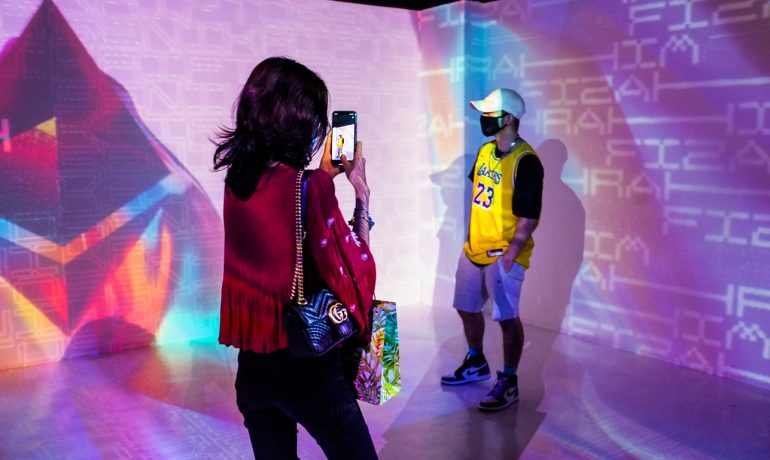Digital artists love it but traditional artists scorn it. Three artists give us their takes on the overnight phenomenon of NFTs.
By Ellen Lee
Earlier this year, the digital artist Mike Winkelmann, more famously known as Beeple, made international headlines for selling a non-fungible token (NFT) through the international auction house Christie’s for $69,346,250. The sale has inspired excitement among digital artists all over the world, many of whom misguidedly view it as a get-rich-quick scheme, while at the same time inspiring scorn among traditional artists, many of whom misguidedly view it as a get-rich-quick scheme. In Malaysia, the art market has been slow to pick up on NFTs, but the stirrings are there. They’re just not in the places we’d normally look.
Though many in the art scene aren’t aware of it, a lively NFT scene does in fact exist in Malaysia, mostly among graduates of design, multimedia studies, 3D and motion graphics, animation, engineering, programming, and architecture. And even medicine, as in the case of Ronald Ong, a Penang-based medical student who’s found massive success in selling his digital artworks as NFTs. While an NFT can be minted for both digital and physical art objects, many NFTs at the moment are digital artworks whose creators, like Ronald, see art more as a hobby than a career.
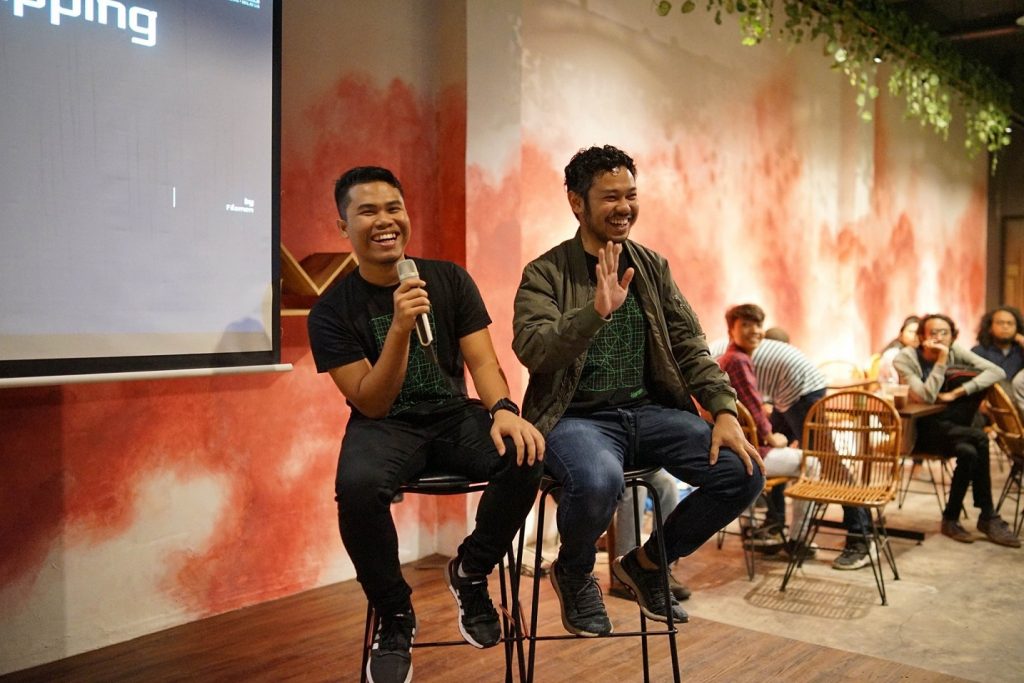
Filamen co-founders Shakir (left) and Fariz (right) leading a projection mapping workshop.
Photo courtesy of Filamen.
An exciting new revenue stream for digital creatives
One prominent voice in the local NFT scene is Filamen, a collective of multidisciplinary digital creatives co-founded by Abdul Shakir and Fariz Hanapiah. Filamen are most known for their projection-mapping work, making them a go-to for commissions among the events circuit. Remember when the Town Hall was lit up with all sorts of psychedelic neon patterns during George Town Festival in 2019? That was them. In Malaysia, they’ve been at the forefront of a lot of the multimedia, light-and-space type installations that have become so attractive and Insta-worthy among young audiences.
Filamen also runs Digital Art Gallery (DAG), a physical space in Kuala Lumpur highlighting digital artists. In April, they launched Seni Kripto (English: “Cryptoart”), an exhibition showcasing works by Azarikh, Faris Nasir a.k.a. Vuevossa, and Fizah Rahim. ‘The exhibition wasn’t really about selling the works—the main reason we did it was to raise awareness about NFTs, and to launch this platform to help anyone who wants to start getting into NFTs,’ shares Shakir. All three exhibiting artists have minted their work as NFTs, but Filamen doesn’t take a cut. Dispensing with the conventional gallery practice of taking commissions from artwork sales, Filamen sustains DAG by charging visitors a small entrance fee of eight ringgit.
‘As digital artists, the main obstacles we’ve faced in our careers have been galleries,’ Shakir says. ‘Either they’re unable to exhibit our works, because they don’t have the tech for it, or they don’t know how to sell it, because it’s not something physical. The obvious option is to create prints, but we feel this undervalues the work, which is supposed to be experienced digitally.’
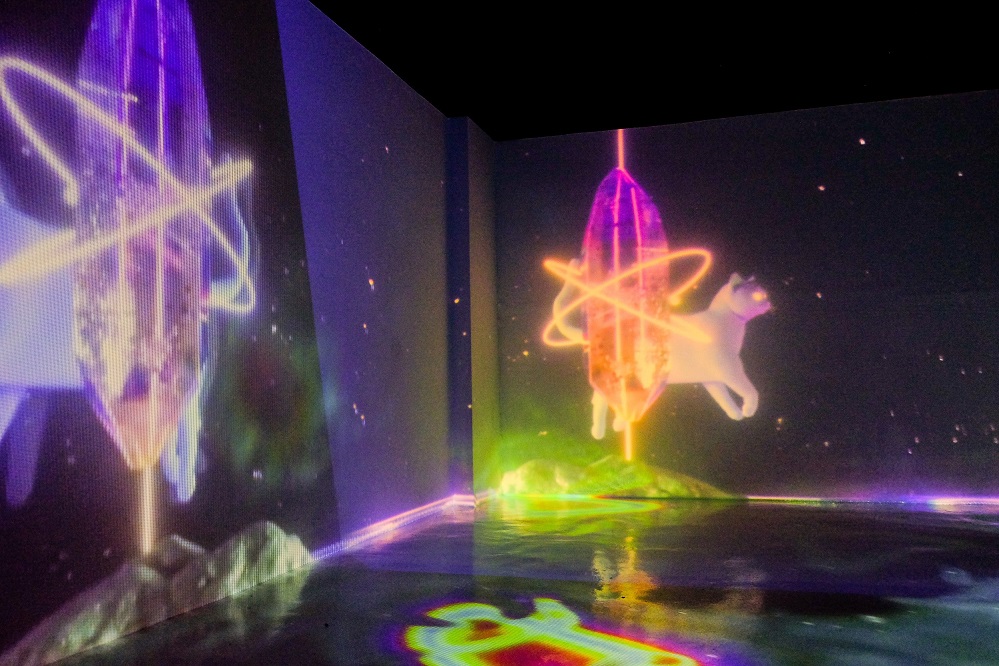
Elevate by Azarikh, as exhibited in Seni Kripto.
Photo courtesy of JD Chang.
Indeed, one of the possible benefits of the current hype surrounding NFTs is that galleries are now forced to rethink and re-strategise around the abundance of digital and new media art that they’ve previously left out.
Another collective straddling both digital and physical realms are No-To-Scale, an architectural design duo with a sizable following on social media. Recently, they’ve exhibited three NFTs as part of the Constructing Worlds online exhibition and published a three-part infographic series about NFTs that’s a helpful explainer for those wanting to go “beyond the hype”. As a collective, they embody the multi-hyphenate nature of the current moment in creative design, which is never purely about commercial utility, but often a synthesis of research, curation, and an adeptness with both analog and digital mediums.
‘We got into NFTs because we were looking for ways in which we could create digital assets of our works, which are mainly digital,’ says Sam Sahrum, one half of No-To-Scale. ‘After looking within that NFT sphere, we saw that there’s an opportunity to create an alternative revenue source for our practice.’
He echoes Shakir’s sentiments on the difficulties of gaining gallery acceptance as a digital creative. ‘NFTs give creatives and digital natives the ability to make their own revenue out of their own digital creations. The art world mainly focuses on physical artworks as being the most sought-after object, but now there’s a way for digital natives doing videos, animations, and such to be on par with that.’
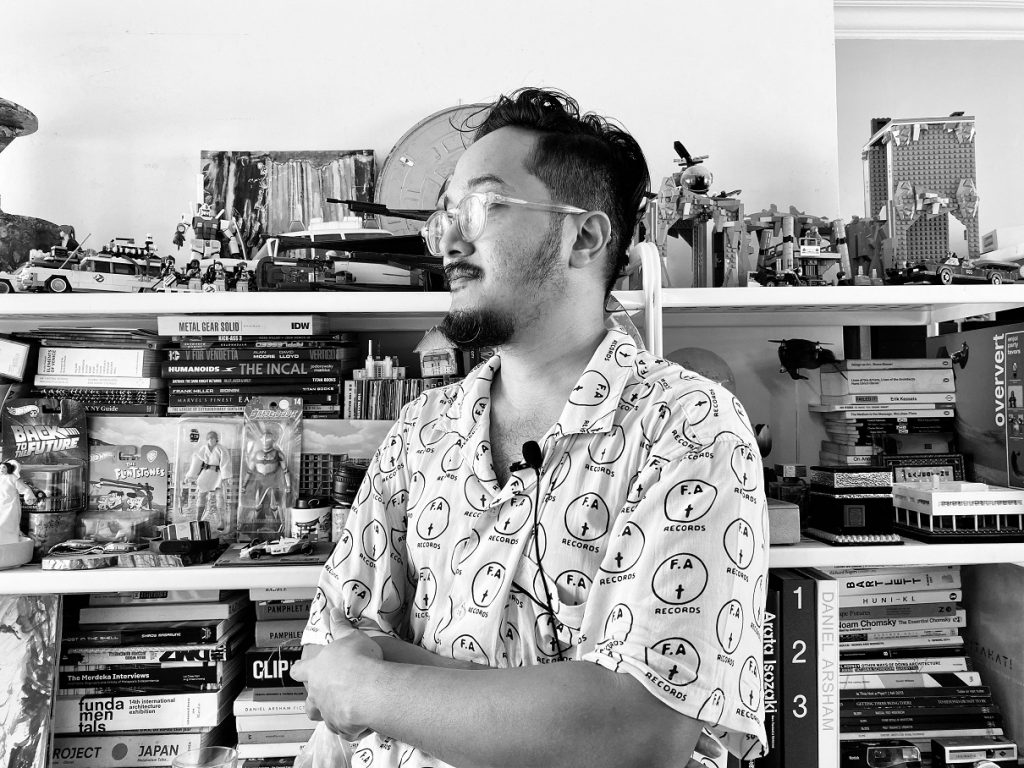
Sam Sahrum of No-To-Scale.
Photo courtesy of Sam Sahrum.
The traditional art world allegedly values “taste” while the NFT world is about trends, memes, and experiences. Scrolling through the landing pages of OpenSea, Rarible, Foundation, or any one of a growing number of online NFT marketplaces, one encounters bright colours, hypnotic motion graphics, and a lot of pop culture references; qualities not dissimilar to the works of some contemporary art market hotshots like KAWS, Takashi Murakami, Yayoi Kusama, and—godfather of bringing fame and hype into art, still one of the most widely-collected artists around—Andy Warhol.
Among the traditional art market, Beeple’s multimillion-dollar Christie’s sale elicited some derision due to the vulgar and cartoonish nature of the artworks. (Beeple himself calls some of them “a big pile of a**-s***”.) But among digital creatives, according to Shakir, ‘Beeple is like our God. He’s been giving out free stuff for many, many years. For example, he makes all his 3D models, animations, project files open source. So for us, when he sold that work with Christie’s—we felt that he really deserved it la.’
Traditional artists are wary, for good reason
In the local art scene, the idea of hype is treated as something of a slur. ‘I make art because I want to make art. That’s all. And so I feel like my motivations as an artist aren’t represented by what the NFT world is all about,’ says chi too, a multidisciplinary artist who’s recently exhibited at The Zhongshan Building and ILHAM Gallery, and who’s considered a senior artist within the Malaysian art scene.

The First Emoji (1-Sep-20), one of the works that make up Everydays: The First 5000 Days.
Everydays was sold for 42,329 Ether ($69,346,250.00 USD) to MetaKovan, an entrepreneur and programmer based in Singapore.
‘As a way to track authenticity for non-tangible objects, I think NFTs are a great idea, but I think the spirit is a bit problematic, in the sense that it’s mostly hype,’ chi too continues. ‘When things become hype, when the entire conversation revolves only around the monetary value of something, people end up creating a lot of bulls***.’ Indeed, NFTs broke into the mainstream with an artwork that was essentially an information overload—Beeple’s Everydays: The First 5000 Days, the work that made headlines, was a patchwork of the artist’s daily output for over 13 years; some of which, as already mentioned above in less euphemistic terms, fall short of the artist’s own standards.
It seems unlikely that the Malaysian art scene would be voluntarily embracing NFTs anytime soon. But, they might eventually be forced to accommodate it, just like how world economies have been forced to reckon with the rise of cryptocurrency. ‘The Malaysian market is ready for NFTs,’ says Sam, ‘because markets are global now. Everyone is a global consumer.’ And the medium for that global consumption is digital technology.
Shifting mediums, shifting mindsets
With children gaining access to technology at an increasingly younger age, the usual mediums for self-expression will shift accordingly. ‘There’s so many young people graduating with tech-related degrees, so a much bigger platform will be needed to accommodate them all. I think we’ll definitely see more digital art in the future, because it’s what young people are interested in,’ says Shakir.
His fellow co-founder, Fariz, jumps in with his belief that artists and galleries stand to learn a thing or two from blockchain technology. ‘I think more artists will adopt blockchain technology to authenticate their artworks, regardless of whether it’s digital or physical. It’s a much more effective way to avoid plagiarism.’
No-To-Scale and Filamen have built up their reputations outside of the commercial art sphere, while chi too has been an observer and actor within it for years. His take is a little more skeptical. ‘Will NFTs be a thing in Malaysia? I don’t think so,’ he reckons. ‘Malaysian artists, galleries, and collectors aren’t very receptive to things happening outside Malaysia. Many commercial artists tend to pander to their established collectors’ interests, and if there isn’t a demand for NFTs among collectors, it’s hard to see artists branching out into it.’
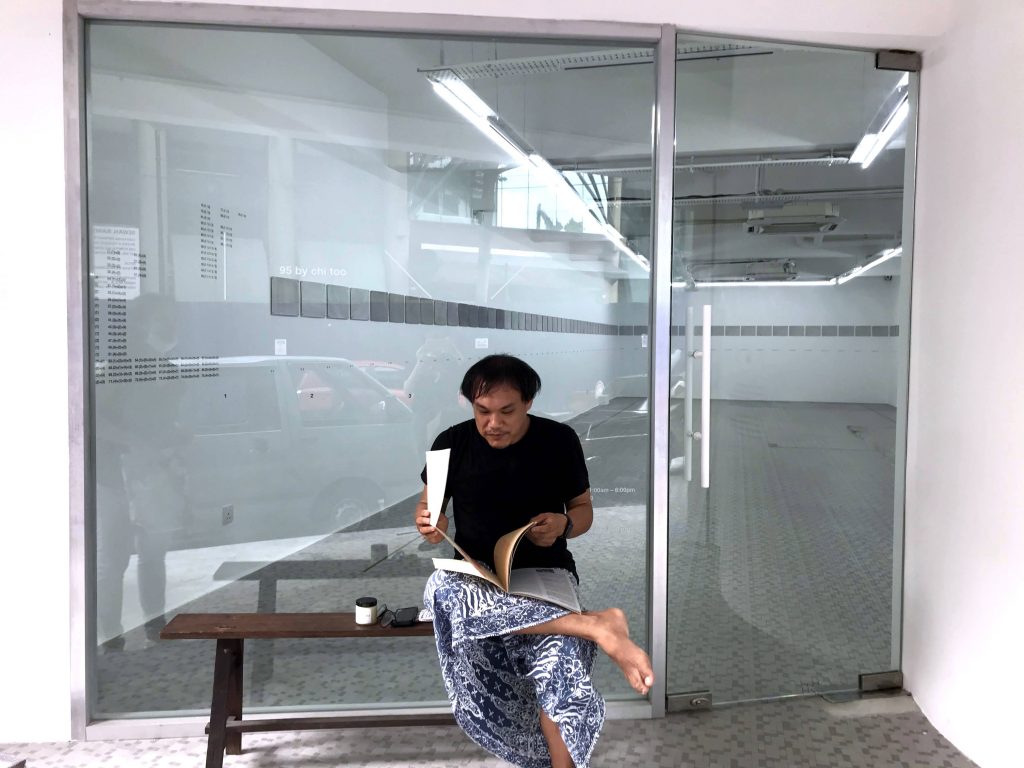
The artist chi too in front of his most recent exhibition, 95, at The Zhongshan Building in October 2020.
It would seem that the NFT scene and the art scene are both guilty of misconceptions about each other. Digital artists, who might be more accustomed to commissions and the availability of money, may feel rejected by the art world, but the truth is that it’s difficult even for most traditional artists to make a living simply through gallery sales. For digital artists looking for an alternative revenue stream, trying their luck with NFTs is no better nor worse an idea than trying their luck with a commercial gallery. On the other hand, artists (in the traditional sense) generalise all NFT artists as mere opportunists jumping on a doomed bandwagon. The truth is that both types of artists care a lot more about their work and their mediums than money can measure.
Whether NFTs have a future in Malaysian arts remains to be seen, but it definitely seems aligned with the radical, contemporary current that’s brewing among young people today, especially late millennials and Gen Z-ers, who have less respect for the institutions of yore, and more resourcefulness with using the Internet as a tool. The influence of institutions, experts, critics, professionals, scholars, and “fine” artists have, over the past few decades, been slowly giving way to the influence of the subcultures and communities bred through the Internet. At the moment, the art of NFTs looks nothing like the art we’re used to seeing in prestigious galleries and museums. Whatever it is or turns out to be, the energy behind it is definitely sincere, and therefore infectious.
Cover image: Audiences at the Seni Kripto exhibition posing for a photo in front of Purpleth by Fizah Rahim. Photo courtesy of Filamen.
Ellen Lee is a writer based in Kuala Lumpur. She is interested in all forms of culture, from fine art and poetry to trap music and anime.

